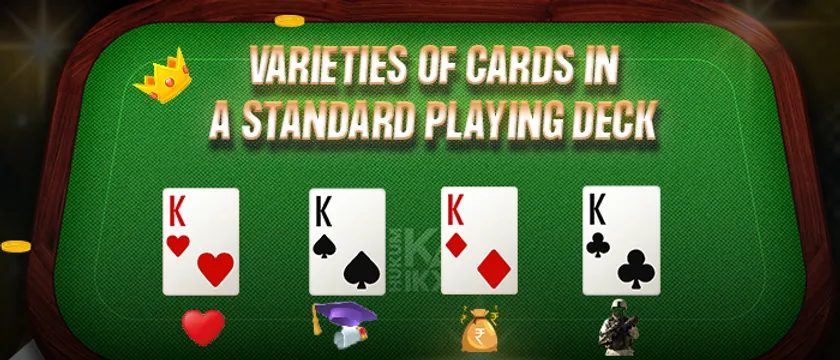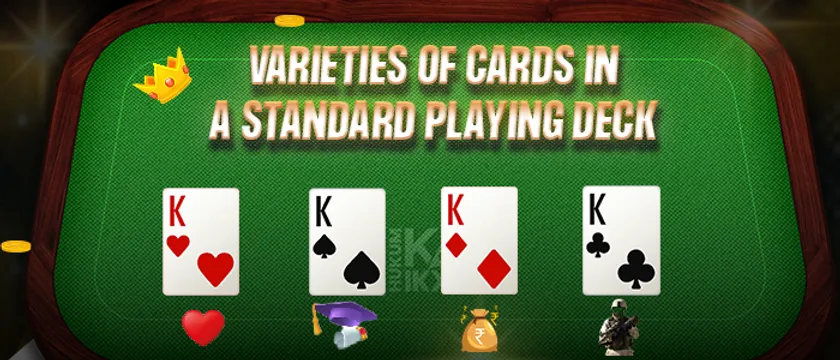
A standard playing deck consists of 52 cards, divided into four suits: hearts, diamonds, clubs, and spades. Each suit contains 13 cards, including numbered cards from 2 to 10, and four face cards – the King, Queen, Jack, and an Ace.
Playing Card Games with a Standard Deck
For centuries, playing cards have been a simple yet fascinating form of entertainment. These small, rectangular pieces of cardboard are central to numerous games, from the excitement of poker to the solitary challenge of solitaire, and even in displaying card tricks. Despite the variety of games, the basic design of the deck remains consistent. But have you ever thought about the detailed designs, the meanings, and the history behind each type of card in a deck? Let’s explore more about the composition and different types of playing cards.
Read more: The Role of joker Cards in Rummy
5 Basic Types of Cards in a Playing Deck
A standard deck of playing cards has 52 cards, split into four suits: Hearts, Diamonds, Clubs, and Spades. Each suit includes 13 cards: the numbers two through ten, and the face cards – Jack, Queen, King, and Ace.
1)Suits:The Core Elements of a Playing Deck:
- Hearts and Diamonds: These red suits have deep meanings. Hearts symbolize love and are inspired by ancient Greek and Roman heart shapes. Diamonds represent wealth but also the challenges that come with it.
- Clubs and Spades: These black suits have their own symbols. Clubs, shaped like a three-leafed clover, may link to growth and farming. Spades, looking like a spearhead, often represent the military and power.
2)The Royal Face Cards:
- King: Represents authority. Each King in a deck looks different, like the King of Hearts, known as the “suicide king” for his unique sword position.
- Queen: Symbolizes femininity and strength. Each Queen has a special style; for example, the Queen of Spades is sometimes called the “bedpost queen.”
- Jack: Stands for youth and creativity. The Jack is a bridge between the numbered cards and the powerful face cards.
3)Numbered Cards (Two to Ten):
These cards are straightforward, each holding its face value. They are crucial in games, as their numbers often decide the game’s direction.
4)The Singular Ace:
The Ace is a versatile card, being the highest or lowest in games. It’s historically significant, like the Ace of Spades, which was marked for tax in England. This card often has unique designs.
5)Special Mention – Joker Card:
Not always used, but a standard deck might have one or two Jokers. They’re colorful and play unique roles in games like rummy, where there are two types of jokers: Printed and Wild. The Joker’s origin comes from the Euchre game, where it was the highest trump card.
The Meaning and Influence of Playing Cards
Playing cards have been seen in different ways over time. Some people find special, hidden meanings in them, similar to tarot cards. They think the four suits symbolize life’s key aspects: Emotions (hearts), Wealth (diamonds), Education (clubs), and Military (spades).
Also, playing cards have left their mark on culture, inspiring phrases like “Ace up one’s sleeve” and “Queen of Hearts” in our daily language, showing how important these cards are in society.
Understanding the Cards in a Deck
A deck of cards may look simple, but it’s full of history, meaning, and impact on culture. From the beautiful face cards to the simple numbered ones, each card tells its own story. Whether you just play cards for fun, love everything about cards, or are interested in their historical and symbolic significance, knowing about the different types of cards helps you enjoy and appreciate this classic form of entertainment even more.
